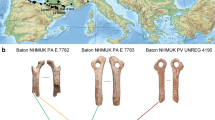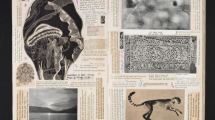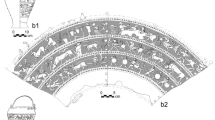Abstract
This article examines the ancient literary evidence for information regarding the ingredients and processes employed to make mortar, plaster, and sealants. The information from the authors is examined chronologically and within the genre and literary context in which it occurs to evaluate better the intention of the author. The challenges presented by the transmission of the manuscripts to the modern day and by the ambiguous and technical language sometimes employed are presented. Terms and expressions are compared between authors to determine how and to what degree such ambiguities can be resolved. The goal is to present a methodology for approaching ancient texts rather than to provide a definitive interpretation of their meaning, a task which is sometimes not possible given the nature of the evidence. Finally, a series of best practices is suggested for those approaching the texts without the benefits of philological training.
Similar content being viewed by others
Data availability
All sources are published.
Notes
For the use of pitch in Greek construction, see references in Martin 1965: 20, 66, 422–3.
Vitruvius (De arch. 2.1), in his explanation of the origins of architecture, equates earthen-based mortars with more primitive stages of development and barbarian building methods, but the Latin agricultural writers make clear that they were commonly used in farm buildings.
For example, Pliny (HN 36.135) refers to silex from Luna, which should indicate Luna marble.
Vitruvius (De arch. 2.6.2–3) uses “spongia” to refer to a type of volcanic scoria.
Procopius (Aed. 1.1.53) (sixth century CE), when describing mortar, equates άσβεστος (ásbestos) with τίτανος (títanos), when he actually seems to be referring to mortar rather than lime. Elsewhere (Aed. 2.1.10, 3.3.12) he refers simply to τίτανος (títanos) again in a context that seems to refer to mortar. His use of both terms to signify mortar rather than lime could reflect a change in usage over time.
Theophrastus, On Stones 9, 68; For discussion of Greek terms for lime, see Orlandos 1966–68, vol 1: 136–8.
Pliny (HN 33.94) also mentions a type of stone with similar properties from Thrace (Thracius lapis). This comment is probably taken from Theophrastus (On Stones 13). See commentary in Caley and Richards 1956: 80–3.
Macerata: Vitr., De arch. 7.2.1, 7.2.2; Plin., HN 36.177; Faventinus 20; Palladius 1.14. Restincta: Lex parieti faciendo Puteolana 2.16–21. Extincta: Vitr., De arch. 2.5.1; Faventinus 20; Augustine, City of God 21. Temperata: Palladius 1.9.4.
Intrita is only used by Pliny (HN 36.176). The meaning can be inferred from the context and from his other uses of the adjective.
For κονιάμα (koniáma) as plaster: Demosthenes, Orations 13. On Organization 30; Aristotle, Problems 11.7; Diodorus Siculus 5.12.2, 20.8.3; Philo of Alexandria, De agricultura 37.160, De Cherubim 29.104.
Quicklime can be slaked so that it becomes a putty or a powder. To create a putty, more water than lime is used, whereas if less water is used, the quicklime is hydrated to a powder with the excess water being removed as steam, as is common nowadays. Hydrated lime powder can then be combined with water later to create a lime putty for mortar. The implication of the ancient writers is that slaked lime was used in putty form.
For discussion, see Caley and Richards 1956: 214–15, 220–1.
Bartoldus 2012: pp. 15–35 argues that Palladius was from Gaul based on a prosopographical analysis, but there is no internal evidence from the manuscript to prove it.
Orlandos (1966–68: 139–40) cites volcanic ash in some examples of Classical and Hellenistic mortars at Thera, Delos, and the port at Zea, so there may have been localized knowledge of the benefits of volcanic ash in lime mortars before the practice developed more fully in Italy.
Seneca (Q Nat. 3.2.3) also notes that similar phenomena occur in some places in Italy, and he cites the waters of Albula, which is at Tivoli and is what created the travertine deposits there. So, this phenomenon is apparently the result of precipitation of calcium carbonate from the water.
Chiotis et al. 2001: 330 found crushed terracotta in the paving plaster of the Mycenaean palace at Tiryns.
The use of “cretae”, a word implying chalk, suggests that the testae were chalk-like or finely crushed.
Vitruvius (De arch. 7.4.5) refers to a “testaceum pavimentum,” which has been translated as “a pavement …of pounded brick” (Granger 1935: 101), as “a terracotta pavement” (Rowland and Howe 1999: 91), and as “un pavimento di mattoni” (Corso and Romano 1997: 1043). In Pliny (HN 36.188), it is translated as “a layer of pounded potsherds” (Eichholz 1962: 149). In Faventinus (26) as “a pavement of earthenware” (Plommer 1973: 75) and “a pavement du tuileau” (Cam 2001: 33). In Palladius (1.9), as “a testaceous coat” (Owen 1807: 20) and as “un carrelage de briques” (Martin and Guiraud 1976: 17).
I owe thanks to Eric Kondratieff and Bill Owens for their advice in helping me to interpret and translate this passage.
The practice of compacting earth floors is mentioned much earlier by Cato (Agr. 129) where he recommends using a rammer (pavicula) or a roller (cylindro) for a grain threshing floor.
The early manuscripts have two variations of the phrase, but all read “testis.” H (Harley 2767, ninth century) reads: signis operibus ex testis aut. Three others, E (Wolfenbüttel, Bibl. 132, tenth century), S (Selestad. Bibl 1153, tenth century), and G (Wolfenbüttel, Bibl. 69, eleventh century) read: signinis operibus ex testis a (Rose 1899: 208). For a listing of the various manuscripts of Vitruvius and their designations, see Granger 1933: xxxii–xiii.
References
Aceto M (2021) The palette of organic colourants in wall paintings. Archaeological and Anthropological Sciences. https://doi.org/10.1007/s12520-021-01392-3
Adam J-P (1994) Roman building: materials and techniques. Batsford, London
Arizzi A, Cultrone G (2021) Mortars and plasters – how to characterise hydraulic mortars. Archaeological and Anthropological Sciences. https://doi.org/10.1007/s12520-021-01404-2
Ash HB (1934) Marcus Porcius Cato, on agriculture; Marcus Terentius Varro, on agriculture. Loeb Classical Library. Harvard University Press, Cambridge, Mass
Ash HB (1941) Lucius Junius Moderatus Columella, on agriculture. Loeb Classical Library. Harvard University Press, Cambridge, Mass
Bailey KC (1932) The Elder Pliny’s chapters on chemical subjects, vol 2. Edward Arnold, London
Bartoldus J (2012) Palladius Rutilius Taurus Aemilianus: Welt und Wert spätrömischer Landwirtschaft. Wissner, Augsburg
Becker H (2021) Pigment nomenclature in the ancient Near East, Greece, and Rome. Archaeological and Anthropological Sciences. https://doi.org/10.1007/s12520-021-01394-1
Bernárdez Gómez MJ, Guisado di Monti JC (2007) Las referencias al lapis specularis en la Historia Natural de Plinio El Viejo. Pallas:49–57
Blake ME (1947) Ancient Roman construction in Italy from the Pre-historic period to Augustus. Carnegie Institution of Washington, Washington
Boynton RS (1980) Chemistry and technology of lime and limestones. 2nd rev. edn. Wiley, New York
Braconi P (2009) Ostracus, asterico e lastrico. I pavimenti in cocciopesto degli antichi e l’opus signinum dei moderni. In: Angelelli C (ed) Atti del XIV Colloquio dell’Associazione italiana per lo studio e la conservazione del mosaico (Spoleto, 7–8 febbraio 2008). Tipografia Mancini, Tivoli, pp 371–83
Brandon CJ, Hohlfelder RL, Jackson MD, Oleson JP (2014) Building for eternity: the history and technology of Roman concrete engineering in the sea. Oxbow, Oxford
Buffone L, Lorenzoni S, Pallara M, Zanettin E (1999) Le macine rotatorie in rocce vulcaniche di Pompei. Rivista Di Studi Pompeiani 10:117–130
Burgio L (2021) Pigments, dyes and inks – their analysis on manuscripts, scrolls and papyri. Archaeological and Anthropological Sciences. https://doi.org/10.1007/s12520-021-01403-3
Caley ER, Richards JFC (1956) Theophrastus, on stones. Ohio State University, Columbus, Ohio
Callebat L, Gros P (1999) Vitruve de l’architecture Livre II. Les Belles Lettres, Paris
Cam M-T (2001) Cetius Faventinus. Abrégé d’architecture privée. Collection des universités de France. Série latine 363. Les Belles Lettres, Paris
Caroselli M, Ruffolo SA, Piqué F (2021) Mortars and plasters – how to manage mortars and plasters conservation. Archaeological and Anthropological Sciences. https://doi.org/10.1007/s12520-021-01409-x
Cavallo G, Riccardi MP (2021) Glass-based pigments in painting. Archaeological and Anthropological Sciences (forthcoming)
Chiotis E, Dimou E, Papadimitriou GD, Tzoutzopoulos S (2001) The study of some ancient and prehistoric plasters and watertight coatings from Greece. In: Aloupi E, Bassiakos Y, Facorellis Y (eds) Archaeometry issues in Greek prehistory and antiquity. Hellenic Society for Archaeometry and the Society of Messenean Archaeological Studies, Athens, pp 327–342
Ciapponi LA (1984) Fra Giocondo da Verona and his edition of Vitruvius. JWarb 47:72–90
Corso A, Romano E (1997) De architectura/Vitruvio. G. Einaudi, Turin
Courrént M (2016) Vitruve et les naturales quaestiones: La théorie de la matière dans le De Architectura. Arethusa 49:251–262
DeLaine J (2021) Production, transport and on-site organisation of Roman mortars and plasters. Archaeological and Anthropological Sciences. https://doi.org/10.1007/s12520-021-01401-5
Domingo Sanz I, Chieli A (2021) Characterising the pigments and paints of prehistoric artists. Archaeological and Anthropological Sciences. https://doi.org/10.1007/s12520-021-01397-y
Eckel EC (1907) Cements, limes, and plasters. Their materials, manufacture, and properties. 1st edn. Wiley, New York
Eichholz DE (1962) Pliny, natural history. Harvard University Press, Cambridge, Mass
Ergenç D, Fort R, Varas−Muriel MJ, Alvarez de Buergo M (2021) Mortars and plasters – how to characterise aerial mortars and plasters. Archaeological and Anthropological Sciences. https://doi.org/10.1007/s12520-021-01398-x
Gargiani R (2013) Concrete from archeology to invention 1700–1769: the Renaissance of pozzolana and Roman construction techniques. École Polytechnique Fédérale de Lausanne, Lausanne, Switzerland
Giocondo G (1511) M. Vitruvius per Iucundum solito castigatior factus, cum figuris et tabula, ut iam legi et intelligi possit. G Taccuino, Venice
Giuliani CF (1992) Opus signinum e cocciopesto. In: DeRossi GM (ed) Segni I. Serie storia antica e archeologia 1, vol 1. Università degli Studi di Salerno, Napoli, pp 89–94
Giuliani CF (2006) L’edilizia nell’antichità. 2nd ed. rev. edn. Carocci, Rome
Gliozzo E (2021) Pigments – Mercury-based red (cinnabar-vermilion) and white (calomel) and their degradation products. Archaeological and Anthropological Sciences. https://doi.org/10.1007/s12520-021-01402-4
Gliozzo E, Burgio L (2021) Pigments – Arsenic-based yellows and reds. Archaeological and Anthropological Sciences. https://doi.org/10.1007/s12520-021-01431-z
Gliozzo E, Ionescu C (2021) Pigments – Lead-based whites, reds, yellows and oranges and their alteration phases. Archaeological and Anthropological Sciences. https://doi.org/10.1007/s12520-021-01407-z
Gliozzo E, Pizzo A, La Russa MF (2021) Mortars, plasters and pigments – Research questions and sampling criteria. Archaeological and Anthropological Sciences. https://doi.org/10.1007/s12520-021-01393-2
Goodman MM (1989) The effects of woodash additive on the structural properties of lime plaster. M.Sc., University of Pennsylvania
Grandi Carletti M (2001) Opus signinum and cocciopesto. Alcune osservazioni terminologiche. In: Atti del colloquio dell’associazione italiana per lo studio e la conservazione del mosaico, Pompeii 22–25 marzo 2000. Edizioni del girasole, Ravenna, pp 183–97
Granger F (1933) Vitruvius, On architecture. vol 1. Loeb Classical Library. Harvard University Press, Cambridge, Mass
Granger F (1935) Vitruvius, On architecture. vol 2. Loeb Classical Library. Harvard University Press, Cambridge, Mass
Gros P (2003) L’opus signinum selon Vitruve et dans la terminologie archéologique contemporaine. In: Ciotta G (ed) Vitruvio nella cultura architettonica antica, medievale e moderna. Atti del convegno internazionale di Genova, 5–8 novembre 2001. De Ferrari, Genova, pp 142–52
Gros P (2015) Fra Giocondo lecteur et interprète de Vitruve. La valeur de sa méthode et les limites de sa logique. Monuments Et Mémoires Fondation Eugène Piot 94:201–241
Guarnieri C, Lugli S, Gullì D, Pisapia MS, Ingravallo V (2015) Il lapis specularis a Pompei ed Ercolano. Riv Stud Pompeiani 26–27:142–5
Healy JF (1999) Pliny the Elder on science and technology. Oxford University Press, Oxford
Hellman M-C (1999) Choix d’inscriptions architecturales grecques. Maison de l’Orient Méditerranéen, Lyon
Jackson MD, Marra F, Deocampo D, Vella A, Kosso C, Hay R (2007) Geological observations of excavated sand (harenae fossiciae) used as fine aggregate in Roman pozzolanic mortars. JRA 20:25–53
Knapp CW, Christidis GE, Venieri D, Gounaki I, Gibney-Vamvakari J, Stillings M, Photos-Jones E (2021) The ecology and bioactivity of some Greco-Roman medicinal minerals: the case of Melos earth pigments. Archaeological and Anthropological Sciences. https://doi.org/10.1007/s12520-021-01396-z
La Russa MF, Ruffolo SA (2021) Mortars and plasters - how to characterise mortars and plasters degradation. Archaeological and Anthropological Sciences. https://doi.org/10.1007/s12520-021-01405-1
Lamprecht H-O (1984) Opus caementicium: Bautechnik der Römer. Beton-Verlag, Düsseldorf
Lancaster LC (2015) Innovative vaulted construction in the architecture of the Roman Empire: 1st to 4th centuries CE. Cambridge University Press, Cambridge
Lancaster LC (2019) Pozzolans in mortar in the Roman empire: an overview and thoughts on future work. In: Ortega IF, Bouffier S (eds) Mortiers et hydraulique en Méditerranée antique. Publications Universite Provence, pp 31–9
Lancaster LC, Sottili G, Marra F, Ventura G (2010) Provenancing of lightweight volcanic stones used in ancient Roman concrete vaulting: evidence from Turkey and Tunisia. Archaeometry 52:949–969
Livadiotti M (2006) Note preliminari sulle techniche costruttive di Coo in età ellenistica e romana. In: Adembri B (ed) Aeimnestos: miscellanea di studi per Mairo Cristofani. Centro Di, Florence, pp 178–87
Lugli G (1957) La tecnica edilizia romana con particolare riguardo a Roma e Lazio. G. Bardi, Rome
Marra F, Anzidei M, Benini A, D’Ambrosio E, Gaeta M, Ventura G, Cavallo A (2016) Petro-chemical features and source areas of volcanic aggregates used in ancient Roman maritime concretes. J Volcanol Geoth Res 328:59–69
Martin, R (1965) Manuel d’architecture grecque. vol. 1, Matériaux et techniques. J Picard, Paris
Martin R, Guiraud C (1976) Traité d’agriculture. Palladius. Les Belles lettres, Paris
Massazza F, Costa U (1977) Factors determining the development of mechanical strength in lime–pozzolana pastes. In: Schneider L (ed) Proceedings of the XII conference on silicate industry and silicate science, vol. 1. SILICONF, Budapest, pp 537–52
Mastrotheodoros GP, Beltsios KG, Bassiakos Y (2021) Pigments – iron-based red, yellow and brown ochres. Archaeological and Anthropological Sciences (forthcoming)
Merriman M (1920) American civil engineers’ handbook. 4th ed. rev. edn. Wiley, New York
Murat Z (2021) Wall paintings through the ages. The medieval period (Italy, 12th-15th century). Archaeological and Anthropological Sciences. https://doi.org/10.1007/s12520-021-01410-4
Ohl RT (1928) The Enigmas of Symphosius. Philadelphia
Oleson JP (2014) Ancient literary sources concerned with Roman concrete technology. In: Brandon CJ, Hohlfelder RL, Jackson MD, Oleson JP (eds) Building for eternity: The history and technology of Roman concrete engineering in the sea. Oxbow, Oxford, pp 11–36
Orlandos AK (1966–68) Les matériaux de construction et la technique architecturale des anciens grecs. vols. 1–2. E. de Boccard, Paris
Owen T (1807) The fourteen books of Palladius Rutilius Taurus Aemilianus, on Agriculture. J White, London
Peacock DPS (1980) The Roman millstone trade: a petrological sketch. WorldArch 12:43–53
Pérez-Arantegui J (2021) Not only wall paintings – pigments for cosmetics. Archaeological and Anthropological Sciences. https://doi.org/10.1007/s12520-021-01399-w
Plommer H (1973) Vitruvius and later Roman building manuals. Cambridge Classical Studies. Cambridge University Press, Cambridge
Rose V (1899) Vitruvii de architectura libri decem. Teubner, Leipzig
Rowland ID (2011) The Fra Giocondo Vitruvius at 500 (1511–2011). JSAH 70:285–289
Rowland ID, Howe T (1999) Vitruvius: ten books on architecture. Cambridge University Press, Cambridge
Russell B, Fentress E (2016) Mud brick and pisé de terre between Punic and Roman. In: DeLaine J, Camporeale S, Pizzo A (eds) Archaeology of construction V. Man-made materials, engineering, and infrastructure, Proceedings of the conference, Oxford April 11–12, 2015. Consejo Superior de Investigaciones Científicas, Mérida, pp 131–43
Rykwert J, Leach N, Tavernor R (1988) Alberti. On the art of building in ten books. MIT Press, Cambridge, Mass
Salvadori M, Sbrolli C (2021) Wall paintings through the ages. The Roman period: Republic and early Empire. Archaeological and Anthropological Sciences. https://doi.org/10.1007/s12520-021-01411-3
Švarcová S, Hradil D, Hradilová J, Čermáková Z (2021) Pigments – copper-based greens and blues. Archaeological and Anthropological Sciences. https://doi.org/10.1007/s12520-021-01406-0
Ungaro L, Giusberti P, Rava A, Prisco L (1993) Emiciclo dei Mercati Traianei. Intervento di restauro delle cortine laterizie. BCom 95.2:181–99
Vitti P (2021) Mortars and masonry - Structural lime and gypsum mortars in antiquity and middle ages. Archaeological and Anthropological Sciences. https://doi.org/10.1007/s12520-021-01408-y
Wiss JE, Camp TP, Ladoo RB (1930) Gypsum plaster in the ceramic industries. J Am Ceram Soc 13:287–314
Lancaster LC (2012) Ash mortar and vaulting tubes: Agricultural production and the building industry in North Africa In: Camporeale S, Dessales H, Pizzo A (eds) Arqueología de la construcción: los procesos constructivos en el mundo romano: La economía de las obras (Paris, Ecole Normale Supérieure, 10-11 décembre 2009). Madrid, pp 145–60
Author information
Authors and Affiliations
Corresponding author
Ethics declarations
Conflict of interests
The authors declare no competing interests.
Additional information
Publisher’s note
Springer Nature remains neutral with regard to jurisdictional claims in published maps and institutional affiliations.
This article is part of the Topical Collection on Mortars, plasters and pigments: Research questions and answers
Rights and permissions
About this article
Cite this article
Lancaster, L.C. Mortars and plasters—How mortars were made. The literary sources. Archaeol Anthropol Sci 13, 192 (2021). https://doi.org/10.1007/s12520-021-01395-0
Received:
Accepted:
Published:
DOI: https://doi.org/10.1007/s12520-021-01395-0




